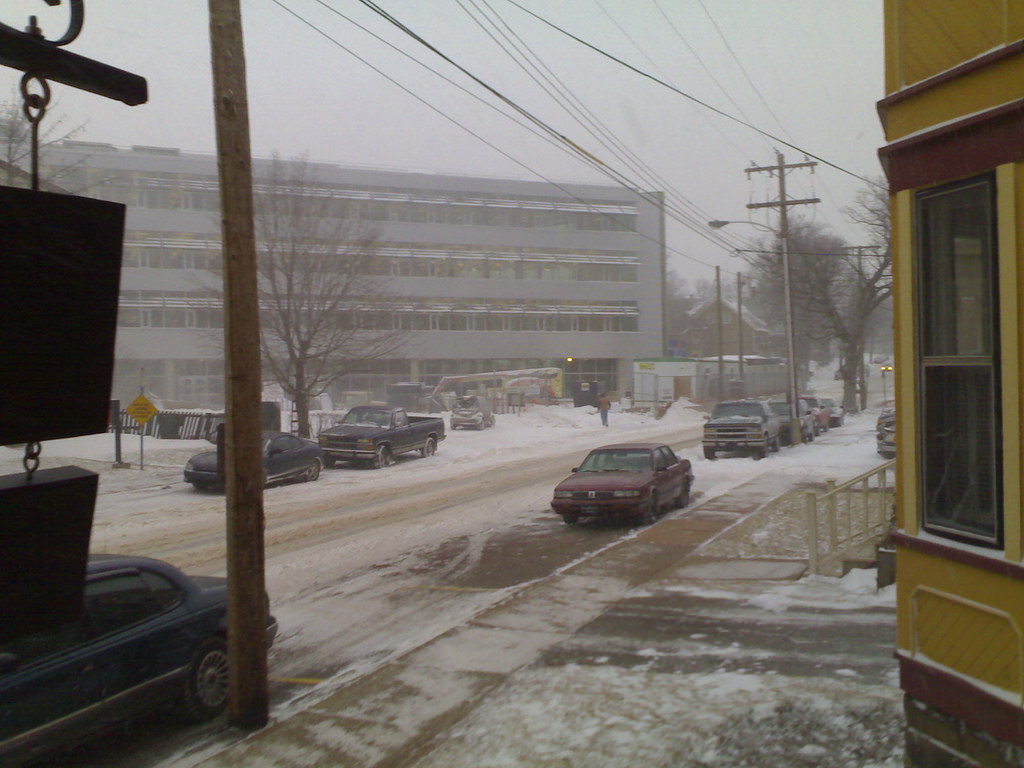The Summits of Canada Expedition is “the single largest expedition of discovery and adventure in Canada” with a goal of “putting the first Canadian team on the summit of every province and territory.”
Here is the route planned for the summit of [[Prince Edward Island]]’s highest point, at Glen Valley (map):
Take Highway 2 to Fredericton to Glen Valley. Turned left onto a dirt road and park car. GPS to a small forest beside a potato field.
Is it any wonder that Islanders are humble folk.
Most Tuesday mornings I read the Sunday edition of the New York Times at [[Beanz]]. And one of the features I like reading are the wedding announcements.
I noticed this morning that the Times has added video to the web version of the announcments, including this video about how Aislinn met Jeffery.
This is an interesting example of how web and print work well together: I can’t imagine deriving any pleasure from reading wedding announcements on the web but I like having the option of going to the web to learn the story behind the story.
It says here on Al Gore’s website that:
Number of gallons of gasoline is multiplied by the emissions factor of 19.6 to convert to pounds CO2, or 22.4 for diesel vehicles. These emissions factors come from the Energy Information Administration, Fuel and Energy Source Codes and Emissions Coefficients.
According to Terrapass, the fuel efficiency of my 2000 Jetta with a manual transmission and standard gasoline is 24 miles per gallon in the city (which is where I usually drive it).
This means that for every one mile I drive I use 0.0416 gallons of gasoline and emit 0.81536 pounds of C02. Assuming my car is out of tune, and has aged somewhat after 40,000 km of driving, and so has poorer gas mileage than that, a figure of 1 pound per mile driven is probably a reasonable ballpark.
The round-trip from our house to the Charlottetown Farmer’s Market is 3.2 miles, so if we drive we emit roughly 3.2 pounds of C02. Over the course of the year, assuming we drive every week, that adds up to 166 pounds of C02 (or 0.08 tons).
The carbon calculator tells me that my personal carbon emissions are 8.1 tons per year (the big contributors to that are flights to Europe and New England and oil heat in our house).
While we’re heavily abstracted from real numbers by this point, it seems like that driving to the Farmer’s Market every week would contribute about 1% of my annual C02 emissions.
It’s interesting to note that when we moved from rural Kingston to urban Charlottetown seven years ago, I cut out a 6 day a week commute of 20 miles return, resulting in a reduction of roughly 6,240 pounds (or 3 tons) of C02 emissions per year.
Please point out the errors in my math and logic if you find any.
I took some time this afternoon to craft together [[JaikuGrowler]], an AppleScript that uses Growl to alert you every time you or any of your contacts emits something into [[Jaiku]]:

The script, which you can grab here, takes advantage of Jaiku’s new RSS feed capabilities. I created it as a sort of poor man’s Twitterific.
Massimo Vignelli explains his 1972 NYC Subway Map, an outtake from the movie Helvetica. In four minutes you can learn almost everything you need to know about design. Almost. Link from Fabrica.
See also Mr. Vignelli’s Map from Design Observer and the map itself. And if you’re passionate about this sort of thing, read Mr. Beck’s Underground Map, which is one of my favourite books.
It hasn’t been the best week for [[Charlottetown]]’s water department. First came the lead problem and now the news that the new sewage plant is giving off a smell that’s covering the neighbourhood. The CBC reports:
The smell is not a total surprise. During the plans for the upgrade, consultants for the city warned that the plant might start giving off a bad smell. The consultants’ concerns were noted, but because of a lack of money nothing was done to stop the problem before it started.
“Okay, so you can get the smelly model for $18.7 million, or you can upgrade to the smell-free model and pay $19.2 million.” The mind boggles.
Days like this it’s possible to get really really sad that spring on [[Prince Edward Island]] is really still 2 or 3 months away. Sigh.

I’ve posted a small selection of photos from our trip to Lisbon. Between the three of us [[Mom]], [[Catherine]] and I took more than 1300 photos; these are just mine, and they’re just the highlights.
A lot of our visit to Lisbon last week was planned around things that would be interesting to six year-old [[Oliver]] (or at least things that would have the appearance of being interesting to Oliver while actually being interesting to me). Here are the top ten kid-friendly things we did over the week; I welcome your comments about others you find.
- Museu das Crianças — the Children’s Museum. Located inside the grounds of the Jardim Zoológico de Lisboa, this is a compact and well set-up museum that’s perfect for young kids. Organized as a series of rooms, each with a central activity, the only difficulty we ran into was that the explanations of everything are only in Portuguese. Fortunately the helpful staff stepped in several times to translate, and many of the activities are self-explanatory. We spent an hour and a half exploring. An excellent way to spend a rainy afternoon. Directions: Take the Metro Linha Azul (Blue Line) in the direction of Amadora Este and get off at the Jardim Zoológico stop. The entrance to the museum is on the right after you walk into the main gates of the zoo. Note that there are limited hours in the winter; when we visited the museum was only open on weekends.
- Museu da Carris — the Public Transit Museum. When [[Oliver]] and I visited we were, I think, the only visitors that day, as they had to find someone to unlock the doors and turn on the lights. But it was a worthwhile visit nonetheless. The museum is located inside the working transit yard and garage on the Lisbon waterfront directly under the Ponte 25 de Abril suspension bridge. After paying admission in one building, you walk next door to the first of two exhibit halls, which presents a history of public transit in Lisbon through artifacts and information panels. At the exit of this hall you wait for a old-style trolley to come and pick you up; this was the highlight of the visit for us. The trolley takes you through the yard — the driver has to get out several times to switch the tracks with a giant metal bar — and you end up at a second hall which is cavernous and contains a good collection of old trolleys, work vehicles and buses, as well as an interesting exhibit about the history of the ticket printing shop. When you’re done with the second building, the trolley takes you back to the entrance. For kids who like trolleys and machines and things that go, this is a great place. Directions: from the Cais do Sodré Metro station on the Linha Verde (Green Line), take the E15 trolley towards Algés and get off at the stop under the bridge at the Sto. Amaro stop — the transit museum is well-signed and obvious.
- Museu da Electricidade — the Museum of Electricity. Run by the electrical utility EDP, and housed in a decomissioned coal power station on the Lisbon waterfront near Belém, this museum seems to be missing from most of the Lisbon tourist literature. But it’s a stunning facility, very well put together, and well worth a visit. Perhaps the most impressive part of the museum is its home: it takes up almost all of the Tejo Power Station, a beautiful and imposing brick building that has been completely resuscitated. The museum uses the parts of the power station — furnaces, boilers, coal chutes — as the basis for explaining the history of power generation. Many of these parts have been imaginatively cut away to reveal their innards; you can, for example, walk right through one of the furnaces. In the basement there is a collection of excellent child-focused electricity exhibits that teach about voltage and amperage and about electricity safety. There is also, just outside the exit, an intriguing restaurant that serves excellent food; it’s odd to eat beside a hulking generator, odder still because the restaurant is all hip and modern and red leather chairs. Directions: from the Cais do Sodré Metro station on the Linha Verde (Green Line), take the local commuter train to the Belém station; you’ll see the museum across the tracks when you get off the train.
- Museu das Comunicações — the Communications Museum. This museum covers the history of printing, postal service, television, radio and the telephone in Portugal. There are several really neat exhibits: a working telephone switch, with a collection of old telephones each with its own “phone number” lets you call one phone from another and see and hear how telephones actually work. The first-floor mock-up of a old mail wagon and associated neighbourhood contains eerily life-like mannequins and, very pleasantly, no “velvet ropes” — you can walk in and amongst everything. Near the entrance there’s an excellent and inexpensive cafeteria, a public Internet site (Internet access is 75 Euro cents for 30 minutes) and a small shop. Directions: from the Cais do Sodré Metro station on the Linha Verde (Green Line) walk to Rua do Instituto Industrial.
- Parque Florestal de Monsanto — Monsanto Park. This is a huge park located very close to downtown Lisbon. It’s accessible from several different directions by bus, and there are several facilities inside the park boundaries, including a children’s area, walking trails, a restaurant, a horse-riding centre and a botanical garden. When [[Oliver]] and I visited, we tool the local train to the Benfica station, and then took number 24 bus into the park from the north, getting off at the Parque Recreativo do Alvito. We walked through this area — it contains a BMX bike track, a skateboard park, a roller skating rink and small playground — and along the main trail to the high overlook which offers a view of both the river and the Atlantic as well as most of downtown Lisbon (Oliver was very excited because there were also water fountains every 10m or so; he stopped at every one). It was a great break from the noise of the city, and great way to spend a quiet afternoon.
- Ride the Trolleys and Funiculars. While the transit system in Lisbon is modern and efficient (if a little over-stretched capacity wise at certain times of the day), several of the trolley lines in the centre core of the city continue to use classic old electric tram cars. With wooden interiors and old-style controls, riding on one is, quite literally, like taking a ride back in history. And because they operate up out of the downtown valley into the hills, riding on them is somewhat like riding a roller coaster in parts. Similarly, the funiculars and the Santa Justa Lift — a large elevator that runs from downtown up into the Bairro Alto district — are of a classic vintage, and are lots of fun to ride. The best deal in town, transit-wise, is the 7 Colinas card — for 13.50 EUR you get unlimited riding on the metro, buses, trams, funiculars and the lift. If you’re moving around a lot this is a super deal; even if you’re not, the simple convenience of not having to have change on hand (you simply wand the card in front of the readers when you board) is worth it.
- Oceanério de Lisboa — the Oceanarium. I’m usually not a big fan of aquariums, but this is a pretty good one, and certainly the best of the ones I’ve visited (the Havana Aquarium probably ranks as the most depressing). It’s located on the Expo 98 site in the eastern area of the city. The building itself is impressive — it juts out into the water and is reached by an interesting series of ramps. Inside there is a large central tank that you see at many junctures as you tour through the facility; on the walls opposite are a series of smaller aquariums and displays illustrating particular oceans of the world. There is a strong emphasis on habitat preservation. The route through the Oceanarium is dark in places, so if you have kids who are averse to that (or, indeed, averse to crowds, as it can get close in places), you might want to give this a pass. But otherwise it’s a good stop. Directions: take the Metro Linha Vermelha (Red Line) to the Oriente station; the Oceanarium is located on the waterfront, accessed by walking through the large shopping mall across the street.
- Pavilhão do Conhecimento - Ciéncia Viva — the Knowledge Pavilion - Living Science. Also part of the Expo 98 site — it’s right beside the Oceanério de Lisboa and you can purchase a combination ticket that allows entry to both — this is a classic science museum in the style of the Ontario Science Centre or the Exploratorium. There are three large halls, one with permanent exhibits and the other two with temporary exhibitions. When we visited the main exhibition was a series of displays and experiments built to illustrate gender similarities and differences: upon entry you were give a gender-coded bar-code to wear on your arm that you scanned at each exhibit before completing a task. At the end of the hall you could see your results compared to others, and learn more about where (and where not) gender plays a practical role. Elsewhere there were the usual “make electricity with a potato” exhibits that you’d see at most every science museum, presented in much the same fashion. Documentation and signs were in Portuguese with English translation provided for many. Directions: take the Metro Linha Vermelha (Red Line) to the Oriente station; the Pavilion is located on the waterfront, accessed by walking through the large shopping mall across the street.
- Visit a Pastelaria. You don’t need directions to find a pastelaria, as there are often three or four on a block and I’d hazard a guess that you’re never more than 10 paces from one anywhere in Lisbon. Part pastry shop, part bakery, part coffee shop, part restaurant, pastelaria are an ever-present source for juice, pastry, Kinder eggs and toilets. We had our morning coffee in the one around the corner every day, and several times while [[Oliver]] and I wandered around the city we found salvation from tiredness and hunger by popping into the nearest one for a coffee and hot chocolate and some sort of pastry.
- Castelo de São Jorge — Saint George’s Castle. Perched on a hill and visible from almost everywhere in the city, the remains of this castle are a great place for kids to explore: there are lots of turrets and stairways and courtyards and it’s all outside and very informal, so it’s not your usual “be careful and don’t touch anything” kind of castle visit. The neighbourhood around the castle is interesting too — lots of tiny winding streets to explore. Indeed the ride up on the tram is half the fun of the visit (you can also take a special shuttle bus, #37, from downtown that drives up closer to the castle than the tram stop). Stunning views of the city and the river.
Update: I’ve created a map of all of the above, with some additions using Google Maps’ new “make your own map” facility.
 I am
I am